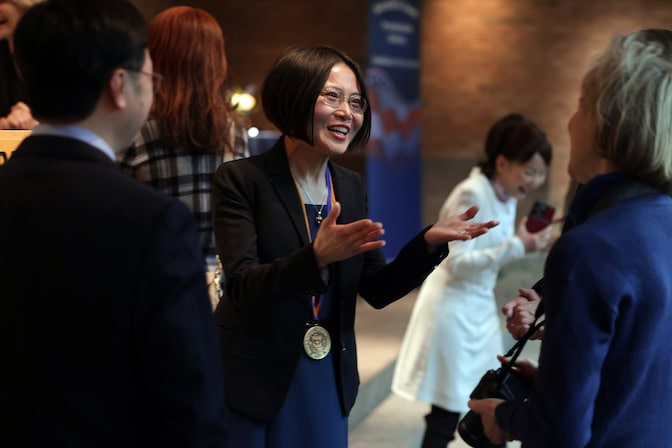
Treating cancer with sound waves
Zhen Xu (MS BME ’03, PhD ’05) co-invented the revolutionary cancer treatment histotripsy.

Zhen Xu (MS BME ’03, PhD ’05) co-invented the revolutionary cancer treatment histotripsy.
In 2002, in a North Campus lab, years of persistence suddenly seemed to have paid off for U-M biomedical engineering master’s student Zhen Xu. She had successfully used ultrasound waves to create a hole in a pig heart which, suspended in a tank of water, served as a stand-in for human tissue. Her success in the lab would eventually change the lives of cancer patients around the world.
Xu’s breakthrough was the genesis of histotripsy, a revolutionary cancer treatment that uses noninvasive sound waves to destroy cancer cells inside the body with no surgery, no radiation and little to no side effects.
The technology directs precisely targeted ultrasound waves at tumors, generating clouds of tiny bubbles. The bubbles’ mechanical action breaks up the tumor cells’ structure, turning them into a harmless liquid called acellular lysate.
Approved by the FDA in 2024, histotripsy has already successfully treated thousands of liver cancer patients around the world, and trials are underway to enable the use of the technology on other cancer types as well.
After the 2002 breakthrough, Xu and her advisor, the late U-M professor Charles Cain, continued to refine the technology, and in 2009 were members of the group that co-founded HistoSonics to commercialize the technology.
“At the time, we didn’t make a huge deal out of it, just dinner and drinks at a nearby restaurant,” Xu said. “We received early support from the U-M Coulter Transitional Research Partnership Program. They focused on developing and commercializing healthcare products. And then U-M’s Innovation Partnerships stepped in to provide intellectual property support.”
The team developed the Edison Histotripsy System, a device now used in hospitals to deliver the treatment. A consortium of investors backed by Amazon founder Jeff Bezos acquired HistoSonics in 2025 for more than $2.25 billion. The acquisition paved the way for accelerated growth of the Edison System across new clinical indications and global markets.
In addition to her work with HistoSonics, Xu has chosen to continue her research at U-M; today, she is the Li Ka Shing Professor in Biomedical engineering, as well as a fellow of the National Academy of Inventors and the Institute of Electrical and Electronics Engineers.
But she says histotripsy’s continued march from the drawing board concept of almost 30 years ago to a clinical treatment reaching more people every day has been a validation all its own.
“One of the best parts about science is turning the impossible to possible,” Xu said. “It has been the challenge and highlight of my lifetime to see our response to a simple question ‘Can we create a non-invasive interventional technology that performs surgery?’ evolve into a platform that is revolutionizing cancer treatment.
“I am proud of what we have accomplished for patients so far, and with this acquisition I anticipate quickly expanding histotripsy to benefit patients with various tumor types and neurological diseases all over the world.”